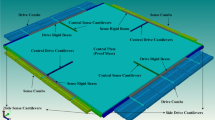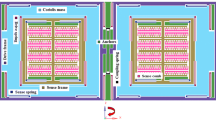Abstract
The rising demand for mobile devices with photo cameras that has the same stability as that of a high-end camera has led to the need for introducing image stabilizing devices that must be inexpensive and efficient. This problem is often addressed using miniature Micro-Electro-Mechanical Sensors (MEMS). The application of resonance MEMS as inertial sensors in navigation systems of low accuracy grade is also relevant. Such devices are manufactured using well-developed microelectronic technologies of silicon processing to obtain layers up to 100 µm thick. Today, much attention is paid to the issues of a sensitive element development for a MEMS gyro with high sensitivity and a minimum possible size. This paper reports one such comb driven, single perforated proof mass MEMS-based Tuning-Fork Gyroscope (TFG) using PolyMUMPs process. In this paper, initially, a full description of design and simulation is done using predictive modelling methods. We propose a miniature perforated mass sized 500*500 µm, highly sensitive to the input signal, with small displacements along the axis of primary oscillations. The value of this work is that it considers a full cycle of a MEMS-based gyroscope’s design, starting from the mathematical model description and up to the study of a manufactured prototype.




Source: MEMSCAP)








Similar content being viewed by others
References
Allen Cowen, Busbee Hardy, Ramaswamy Mahadevan, and Steve Wilcenski, (2011) "PolyMUMPs design handbook." Memscap Inc 13.
Alper SE, Azgin K, Akin T (2007) A high-performance silicon-on-insulator MEMS gyroscope operating at atmospheric pressure. Sens Actuators, A 135(1):34–42
Ashwin A Seshia, Roger T. Howe, Stephen Montague (2002) "An integrated microelectromechanical resonant output gyroscope." In Technical Digest. MEMS 2002 IEEE International Conference. Fifteenth IEEE International Conference on Micro Electro Mechanical Systems (Cat. No. 02CH37266), IEEE, pp. 722–726
Chris C, Painter, Shkel AM (2002) “Active structural error suppression in MEMS vibratory gyroscopes.” In Sensors, 2002 IEEE 2:1089–1094
Fei J (2007) Adaptive sliding mode control with application to a MEMS vibratory gyroscope. The University of Akron, PhD diss.
Geiger WUBW et al (2002) Decoupled microgyros and the design principle DAVED. Sens Actuators, A 95(2–3):239–249
Guo ZY, Yang ZC, Lin LT, Zhao QC, Cui J, Chi XZ, Yan GZ (2009) Decoupled comb capacitors for microelectromechanical tuning-fork gyroscopes. IEEE Electron Device Lett 31(1):26–28
Kalaiselvi S, Sujatha L, Sundar R (2019) Analysis of damping optimization through perforations in proof-mass of SOI capacitive accelerometer. Analog Integr Circ Sig Process 102:1–11
Lili Dong and David Avanesian (2008) Drive-mode control for vibrational MEMS gyroscopes. IEEE Trans Industr Electron 56(4):956–963
Marc Burnie (2010) "Modal analysis of MEMS gyroscopic sensors." PhD diss., Queen’s University.
Ngana PJ (2009) “Design, modeling and simulation of a 52MHz MEMS gyroscope device in 1.5 um SOI.” Masters Thesis, TU Delft
Pandey AK, Venkatesh KP, Pratap R (2009) Effect of metal coating and residual stress on the resonant frequency of MEMS resonators. Sadhana 34(4):651
Schofield AR, Trusov AA, Shkel AM (2008) Effects of operational frequency scaling in multi-degree of freedom MEMS gyroscopes. IEEE Sens J 8(10):1672–1680
Shakoor RI, Bazaz SA, Kraft M, Lai Y, Hassan MMU (2009) Thermal actuation based 3-DoF non-resonant microgyroscope using MetalMUMPs. Sensors 9(4):2389–2414
Suhas Mohite, Nishad Patil, and Rudra Pratap (2006) "Design, modelling and simulation of vibratory micromachined gyroscopes." In J Phys: Conference Series, Vol. 34, No. 1, IOP Publishing, pp. 757
Sujatha L, Kalaiselvi S, Vigneswaran N (2016) Out-of-plane Characterization of Silicon-on-insulator Multiuser MEMS Processes-based Tri-axis Accelerometer. Sensors & Transd 205(10):63–71
Sung S, Sung W-T, Kim C, Yun S, Lee YJ (2009) On the mode-matched control of MEMS vibratory gyroscope via phase-domain analysis and design. IEEE/ASME Trans Mechatron 14(4):446–455
Sungsu Park and Roberto Horowitz (2003) Adaptive control for the conventional mode of operation of MEMS gyroscopes. J Microelectromech Syst 12(1):101–108
Weinberg MS, Kourepenis A (2006) Error sources in in-plane silicon tuning-fork MEMS gyroscopes. J Microelectromech Syst 15(3):479–491
Yazdi N, Ayazi F, Najafi K (1998) Micromachined inertial sensors. Proc IEEE 86(8):1640–1659
Zaman MF, Sharma A, Hao Z, Ayazi F (2008) A mode-matched silicon-yaw tuning-fork gyroscope with subdegree-per-hour Allan deviation bias instability. J Microelectromech Syst 17(6):1526–1536
Zhong Yang Guo et al. (2010) "A lateral-axis microelectromechanical tuning-fork gyroscope with decoupled comb drive operating at atmospheric pressure." Journal of Microelectromechanical Systems Vol. 19, No. 3, pp. 458–468.
Acknowledgement
We acknowledge the National Program on Micro and Smart Systems (NPMASS) Program for the establishment of National MEMS Design Centre (NMDC) at Rajalakshmi Engineering College. We would also like to thank Dr Rudra Pratap (Professor of Centre for Nano Science and Engineering, Indian Institute of Science, Bangalore who gave us sufficient knowledge on TFG.
Author information
Authors and Affiliations
Corresponding author
Additional information
Publisher's Note
Springer Nature remains neutral with regard to jurisdictional claims in published maps and institutional affiliations.
Rights and permissions
About this article
Cite this article
Selvakumar, V.S., Sujatha, L. & Balasubramanian, V. Constructing and characterizing a novel MEMS-based Tuning Fork Gyroscope using PolyMUMPs. Microsyst Technol 27, 2847–2855 (2021). https://doi.org/10.1007/s00542-020-05129-5
Received:
Accepted:
Published:
Issue Date:
DOI: https://doi.org/10.1007/s00542-020-05129-5




